Eurocom Monster 1.0: Clevo's Little Monster
by Vivek Gowri on May 18, 2012 4:55 AM EST- Posted in
- Laptops
- Clevo
- Eurocom
- Ivy Bridge
- Kepler
Gaming On the Go? Not Quite
This is where you end up paying for the upgrade to the quad-core CPU when compared to the M11x. The Monster comes with a 62Wh battery, and ends up delivering battery life slightly better than the Alienware M14x but well short of the M11x. The ULV Sandy Bridge chips were phenomenal under idle conditions, so the M11x R3 had awesome idle battery life, but in our real world use case scenarios, the M11x R3 had battery life about 20% better than the Monster. The two previous generations of M11x were similarly more power efficient than the Monster, but it’s a sacrifice worth making for the vastly more powerful CPU.
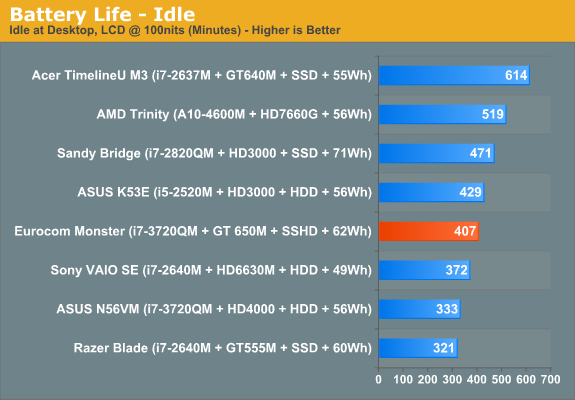
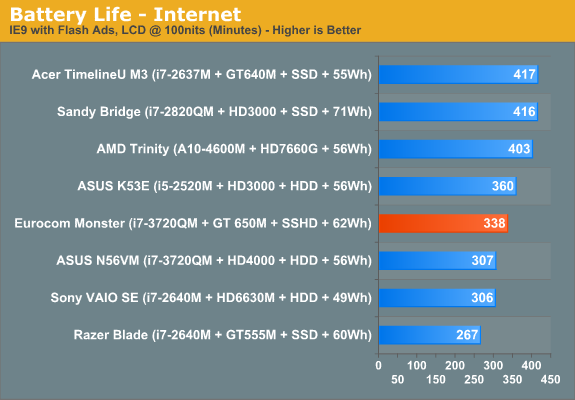
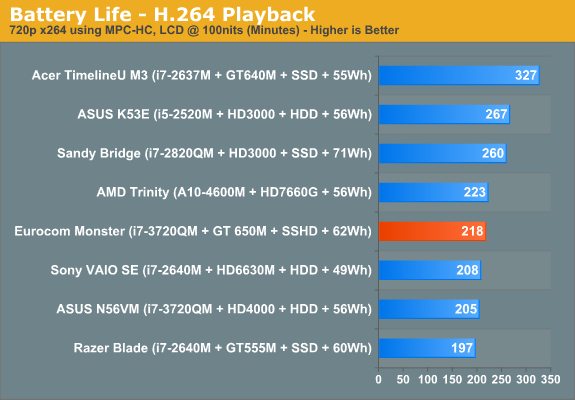

Clevo and Eurocom claim 410 minutes of runtime, and the Monster gets very close to that in our idle battery test, which is the absolute maximum you can expect from the system in an ideal case. Our internet battery test is a much more relevant real world use case scenario, and gives a more realistic estimate of day-to-day battery life, and it slots in at just above 5.5 hours of usable life. I’ve used the Monster as my primary portable for the last ten days or so (including a trip to China) and it’s definitely acquitted itself better than I could have expected.
In terms of gaming battery life (looping 3DMark06), I saw 75 minutes of battery runtime, which is actually pretty decent because we were running the GT 650 in the "prefer maximum performance" setting. For comparison, the ASUS N56VM that served as our IVB test platform ran out of juice at 77 minutes using the HD 4000. But generally, if you're gaming, expect runtime to suffer accordingly.
From a heat standpoint, the numbers aren’t necessarily happy. At idle, temperatures hover in the 60 C range, but load the CPU and GPU and the temperatures climb to the low 90s. I started Furmark and wPrime 1024M (in a loop) and kept it going for a while. After about 10 minutes, temperatures leveled out around 90C for the CPU and motherboard, and 83C for the GPU. That’s….a lot, even higher than the Razer Blade that we tested previously. Do anything more strenuous than surfing and it gets simply too hot to have on your lap. And even under near idle situations like browsing or word processing, the system gets pretty warm to the touch and the fan noticeably kicks in at regular intervals, though unfortunately I don’t have an infrared thermometer to measure the case temps, nor a setup for testing fan noise.
What is very clear though is that the hardware packed into this system is definitely pushing the thermal envelope of the design. There just isn’t enough space to properly ventilate and cool the system via conventional methods. The mechanical engineer in me can think of a few ways that could probably aid in the heat transfer mechanism, but they’re unconventional at best. Quite simply, there needs to either be more surface area to dissipate heat or more airflow to allow for a greater amount of convective heat transfer. Assuming they’re close to constrained for the footprint (which they are, or at least close to it—there’s not too much room to fiddle with the x and y dimensions unless they change the screen size), they just really need to push air through the case. It’s not enough to have a fan for the CPU and GPU, there need to be legitimate case fans, along with a lot more venting. One vent on the left side and a handful of smaller vents on the bottom are clearly not cutting it. Taking certain cooling concepts from desktop cases wouldn’t be a bad idea.


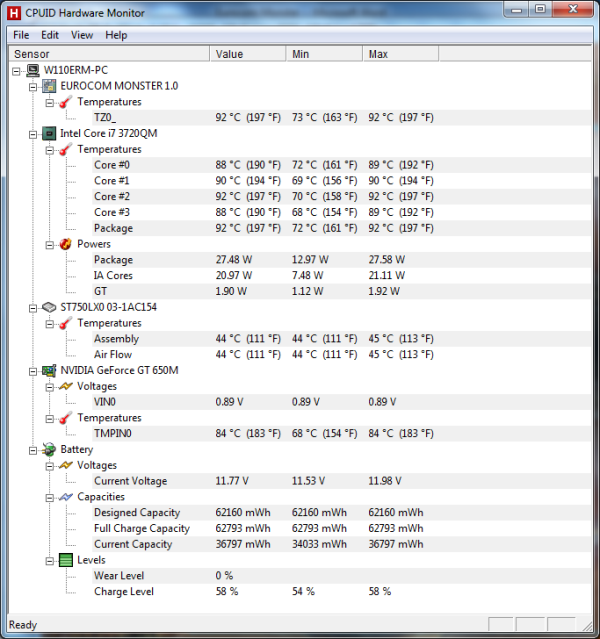
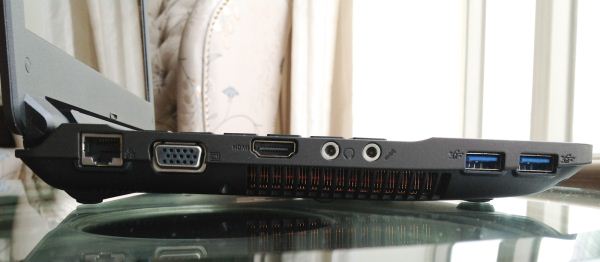








47 Comments
View All Comments
JarredWalton - Friday, May 18, 2012 - link
Your circle of friends and acquaintances must be a heck of a lot more tech savvy than mine, because I can count the number of people I've helped with computer issues that have wired home networks on one hand. I've even encouraged many to consider running wires, and they almost always decline. Granted, I don't live in an area where there are tons of apartment buildings, and neither do most of my family/friends (Washington, Colorado, Utah, Wyoming, Arizona is where we're all located).Daniel Egger - Sunday, May 20, 2012 - link
> ... computer issues that have wired home networks on one handOver here every non-mobile internet user gets a router free or heavily subsidised when closing a contract or changing the provider. 4 ethernet ports are the undisputed standard (though some vendors try to cut costs by only providing 2) on those things and the latest when WLAN problems pop up people will try to use them; usually earlier.
In fact I used to design software for routers and although (thanks to mobile phones) WLAN became more and more important over the years I do not know of a single end-customer or acquaintance who doesn't have at least one Ethernet connection in use.
JarredWalton - Monday, May 21, 2012 - link
A single Ethernet connection doesn't constitute a "wired network" -- it's just a link to the cable modem/router. I know plenty of people with a single computer doing something like this. I'm talking about people that actually have multiple PCs in different rooms where there are Ethernet jacks available. Most everyone I know uses wireless for their console, sometimes wired if the cable/DSL modem is inside in the office -- I know plenty who have their modem installed in the garage, which leads to horrible wireless coverage but apparently avoids unsightly wires. :-\Visual - Friday, May 18, 2012 - link
If they added a multitouch enabled wacom digitizer and a hinge that can convert it to a tablet without bumping the weight too much, I could see myself paying up to $500 more for this.Even better, also drop the keyboard and hinge and make it a pure tablet to shave some weight, include a bluetooth keyboard/touchpad and again they would have my money.
Blindsay04 - Friday, May 18, 2012 - link
Is it too much to ask for for a fairly potent gaming machine (maybe a hair better video card performance then this machine, in around a 13.3" form factor with a GOOD screen? Sick of these terrible screens.kyuu - Friday, May 18, 2012 - link
Agreed, that's exactly what I'd like. A dual-core would be fine though, for better thermals and battery. Or a Trinity with a discrete AMD GPU that can be asymmetrically crossfired.And the screen... why oh why can't they stop sourcing these PoS screens.
Blindsay04 - Friday, May 18, 2012 - link
Id give up the quad and take a better gpu :DIve seen so many machines that come close but it seems no one can just quite get it right
bhima - Saturday, May 19, 2012 - link
Well, you can opt for the better screen at least, so there is an option. The problem is that only the BEST mobile gaming GPUs should be running native 1920x1080 screens. Pretty much anything between 13-16" should have mostly 1600x900 options because these GPUs just aren't powerful enough unless you roll the highest, most expensive ones like the 7970m.This is what PC manufacturers should be doing... building properly balanced systems that take into account screen resolution with the performance of the GPU they cram into the machine.
Eidorian - Friday, May 18, 2012 - link
I'm going to wait for Ivy Bridge ULV options first.versesuvius - Friday, May 18, 2012 - link
"Spiritual Successor"? Aren't you taking this a little too far?